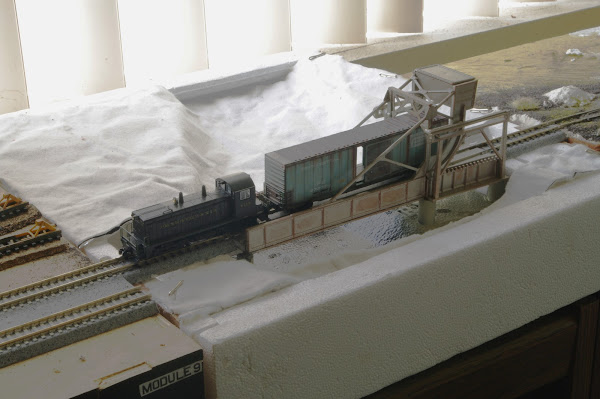A change of management in the late 1950s led to a renumbering of M&StL's locomotives into a more typical system that put them into classes based on model.
I'm not sure when, or even whether, Atlas added an 8-pin DCC socket to this model. Even in the Atlas Classic range, most or all that I've found need to have the PC board replaced with a decoder based on the original shape and mounting method. I've settled on the Digitrax DH165A0. The advantage of these is that a resistance for LEDs is built in, so especially with the Classic version, it's possible just to bend up the leads so the LEDs face the light bars without modification and soilder them directly to the decoder as shown here.Sunday, December 18, 2022
Atlas Classic Minneapolis & St Louis RS-1
Sunday, December 11, 2022
Back To Scenery On The HO Layout
Sunday, December 4, 2022
The METRA Fox Lake Line In 1997
After leaving Union Station, the train passed the Western Avenue coach yard.
I caught some shots of scap rail and ties along the right of way: It looks like 25 years ago, the Rondout tower was still in service, with even a platform for the operator to hand up orders. I checked Google Maps, and all this is now completely gone. The F40Cs that operated on this line were withdrawn in 2004.Sunday, November 27, 2022
A Reminder Of The Start Of The Freight Car Graffiti Era
Cajon Pass in this specific time fame was double track with concrete ties, with the telegraph lines still in place. This would quickly change.
Sunday, November 20, 2022
Scenery On The N Micros
Sunday, November 13, 2022
More Work With The Cardboard T-TRAK Module
Sunday, November 6, 2022
Corrugated Cardboard T-TRAK Architecture
Sunday, October 30, 2022
Up To Hard Shell On The Rolling Bridge Module
Sunday, October 23, 2022
Scenery Work On The "Rolling Bridge" Module
I attached the pieces to the sides of the module with silicone caulk held down with the foam pins provided with the module kit.
Then I connected the module as I'd brought it so far to a temporary T-TRAK compatible layout with power so I could test things out. I got a chepo foam cutter off eBay to cut the shape of the channel into the front and back of the module to match the shape of the channel in the Shaper Sheet. I'll fill in the various gaps with Sculptamold, sand things smooth, and add a finishing layer of the Shaper Sheet plaster included with the module kit. The Woodland Scenics T-TRAK module kit is more expensive than ordinary wood module kits from other sources, but it includes track and scenery material that aren't in those kits, and it's the easiest option for adding something like a stream channel below track level.Sunday, October 16, 2022
More Progress On The "Rolling Bridge"
Sunday, October 9, 2022
The AHM-Pola "Rolling Bridge"
I got the N version, because I figured I could adapt it to a T-TRAK style micro layout or diorama, whereas I don't have a good place to put the HO version on my main layout. Here's a copy of the art on the box:
The model version as produced by Pola, AHM, and Tyco has a brick machinery house and an additional short span that aren't on the prototype, which is located at Wingo, CA on the Northwestern Pacific. This is a line that I occasionally railfan, and I've always wanted to get photos of the prototype, but the area is hard to get to, and even harder in recent years, since the land now seems to be fenced off. However, this is on the NWP's connection to the California Northern and UP, and the bridge is still in use, although it's currently opened very seldom if at all.Here's a photo of the prototype:
Here's the kit as I assembled it. Especially painted silver like the prototype, the detail really comes out nicely. The length of the track on the bridge as I assembed it without the third span at the other side of the draw is 7-1/4 inches, which makes it a good candidate to install in a single-wide 12.20 inch T-TRAK module. However, with only one track, it won't meet T-TRAK standards, but I'll use it as a mocro layout component with the 3-2-2 Inglenook I discussed in my last post.I decided not to make the model operate, as this is more complication than I want to deal with, and the prototype only opens on request with a lot of advance notice anyhow. As far as I can tell, the prototype only has manual operation.
Sunday, October 2, 2022
More Work With The N Micro
Sunday, September 25, 2022
Making A Micro Compatible With T-TRAK
The first question was that the Inglenook would need to be able to interface with the Kato Unitrack/Unijoiners on the T-TRAK modules. I did this by carving a rebate in the baseboard to let me add a short section of Unitrack to the tail track of the Inglenook at the same rail height as the rest of the flex track on it.
The next step was to shim up the Inglenook so it would be at the same height as T-TRAK modules. I also covered the gap in the baseboard around the short section of Unitrack with Sculptamold. With the height established, it was just a press fit to connect them. I had already designed both the Inglenook and my T-TRAK modules to be electrically compatible over a single DCC bus, so running a train from one to the other is no problem: I'll expand the Inglenook as opportunity presents itself with T-TRAK compatibility in mind.
















































